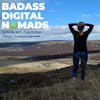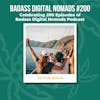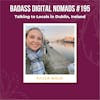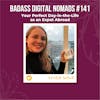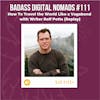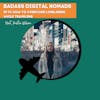Tulum, Mexico: The Good, The Bad, and The Ugly

Kristin shares the highs and lows from her experience traveling to Tulum this month, including some harrowing stories about police corruption and hospital scams. Is Tulum a tropical heaven or "hell", as one famous travel blogger puts it?
Kristin shares the highs and lows from her experience traveling to Tulum this month, including some harrowing stories about police corruption and hospital scams. Is Tulum a tropical heaven or "hell", as one famous travel blogger puts it? Listen in to find out.
Special Offers:
- Discover Cars Discounted International Car Rental
- World Nomads Travel Insurance
- Digital Nomads For Dummies Book
- Visit Costa Rica with Kristin
Topics Discussed:
- Why (or why not) to visit Tulum?
- Mexican Culture
- Expat Community
- Cost of Living
- Coworking
- Internet Speeds
- Safety - Is Tulum dangerous?
- Hospitals Over-Charging Tourists
- Where to Stay
- Things To See and Do
- Transportation and Getting Around
Resources Mentioned:
- Costamed Hospital Reviews
- International SOS App:
- International Travel Insurance:
Places Mentioned:
Coworking:
Related Episodes:
Connect with Kristin and Support the Show:
See the show notes pages on BadassDigitalNomads.com or TravelingwithKristin.com/podcast
Kristin: 00:00:00 That is very concerning because Mexico is a very big medical tourism destination. And so it's very disheartening to hear that a high quality modern hospital is essentially ripping people off.
Introduction: Welcome to Badass Digital Nomads, where we're pushing the boundaries of remote work and travel, all while staying grounded with a little bit of old school philosophy, self-development, and business advice from our guests.
Kristin: 00:00:38 Hey there, Kristin Wilson from Traveling with Kristin here and welcome to episode 249 of Badass Digital Nomads, the longtime travel blogger. Nomadic Matt says hell is a place called Tulum, but is it, I just got back from a whirlwind two week trip to Tulum, Mexico and it was my first time going there since 2013, so more than 10 years. And needless to say, it has definitely changed a lot. Now you may have been to Tulum before. You may have heard about Tulum. It's a historical city that has been around since the Mayan civilization, but it became popular as a tourist destination, especially during the pandemic as Mexico was one of the few countries that didn't shut its borders to tourism during those COVID years. And so a lot of people came down from New York, Miami across the US especially, but also the world to live lives of apparent freedom down in Tulum.
Kristin: 00:01:48 And since then, prices have gone up. More buildings have been constructed, traffic has gotten worse. And just generally the town is experiencing a big development. Boom. It used to be that Playa Del Carmen up the coast of the Riviera Maya was the more popular destination after Cancun. But now it looks like that wave of tourism and development is sweeping through Tulum and beyond. And so in today's podcast I wanted to give you somewhat of a trip report in case you are thinking about traveling there in the future, we're gonna talk about the good, the bad and the ugly, culminating in the craziest healthcare horror story abroad that I have ever heard of by somebody that I personally know. So I'll tell you what happened there, just a disaster. And yeah, I'll give you my authentic, you know, transparent opinion about what I liked about going there, what I didn't like, some concerns I have, and also some travel tips in case you do want to travel there again.
Kristin: 00:02:59 And then I'll also share if I'll be going back or not. As I mentioned, Tulum was a very historically important city and also trade center. It was previously known as Zama, meaning City of Dawn. And it's quite a beautiful place. Think crystal clear, blue water, white sand, beaches, palm trees, breezes and sun, lots of sun. And it is located on the eastern side of Mexico in the Mayan Riviera. This area flourished between the 13th and 15th centuries and kind of faded a bit about 70 years after the Spanish conquistadors started passing through and conquering Mexico. There's some limited information about the past of this city, but uh, estimates put the former population between 1,016 hundred people. And today you can still go visit the ruins of Tulum, which are on cliffs on the Caribbean Sea. Very beautiful. It is a historical preserved area so you do have to pay to go in.
Kristin: 00:04:12 You can't bring anything with you, you can't bring any plastic. You can bring your camera of course, but it's a very beautiful place that I do recommend visiting for its historical significance. And it's also the third most visited site in Mexico and the most visited place in the entire state of Quintana Roo over in that region. It's very rare because it's one of the few walled cities that the Mayans built, but throughout the area you can go to a lot of Mayan ruins from Chichén Itzá to some of the smaller ruins throughout the Mayan Riviera. And then there's also plenty more to do of course going to the beach, relaxing, enjoying the beautiful weather, the amazing food, albeit quite expensive at some times. And also Cenote. So if you've never been to a Cenote, it's a natural pool because Tulum and all of the Mayan Riviera is limestone rock with water underneath.
Kristin: 00:05:16 So there are so many otes, I actually don't know how many there are. Let me Google it really quick. At least 6,000 cenote in the Yucatan Peninsula of Mexico. So this is usually very clear, bluish green water. It kind of reminds me of natural springs in the United States. If you've ever gotten camping or diving or snorkeling, swimming and especially in Florida where I'm from, I actually see a lot of geographical similarities between the Yucatan and Florida. Very flat. Cenote are beautiful. There's some that are very, very basic, almost like going to a hot spring where you can go to a very basic hot spring or you can go to what is essentially a resort built around a hot spring. It's kind of the same way in Mexico with the Cenote. So you can go to some with bars, restaurants, clubs, or just very laid back ones.
Kristin: 00:06:10 And so if you're interested in things like white sand, beaches, cool cenote and clear water and lots of good food nature and places to explore it could be for you. It's also a big hub for digital nomads, expats, coworking, although the internet isn't that great and I'll talk about my experience with that as well. So despite the slow internet, there are a lot of people working remotely from Tulum and all of the people that I talk to seem to basically sacrifice internet speeds for the other benefits that they value about living there versus other parts of the Yucatan. As I mentioned, it's been upwards of 10 or 11 years since I've been in Mexico. So I kind of just wanted to kick things off with my first impressions of the country, especially having been reacclimated to life in the US and also spending a lot of time in Europe over the past few years.
Kristin: 00:07:11 As you might know, I lived in Costa Rica for about eight years and I made a video about why I left Costa Rica back in 2012. And so after spending almost a decade of my life in Latin American countries, I've pretty much been traveling other places since then, just trying to see more of the world and through Europe, Asia, Australia, South Pacific. And so yeah, it's been the first time that I've been back in quite some time, although I did go to Costa Rica back in 2017, so it hasn't been too long in Latin America but just in Mexico in general. And the first thing I noticed was just that everything is so slow. It took probably an hour, hour and a half for me to get my luggage and get out of the airport. And I do remember Cancun airport being quite slow with the baggage. There's no, you know, 20 minute limits like you'll see with Delta and the US for example.
Kristin: 00:08:14 A lot of lines everywhere. But I was able to hop in a shuttle to go pick up my rental car from Avis where I waited in more lines and I think that took about three hours to get my rental car. It must be a new record. I've never seen so many people outside of a a rental car place. But it is really important to have some kind of a vehicle, although we will talk about that in a minute because some people recommend not getting a vehicle so you don't get pulled over by the cops and have them asking for bribes and things. Although that didn't happen to me at all in the two weeks that I was there. If you do go to Mexico, at least through the Cancun airport right now and you want to get a stamp in your passport, then skip the automated scanning machines when you get to immigration and go through the manual immigration line because I just walked right in audit, got the automatic six month 180 day stay and when I was leaving Mexico, I, you have to have this QR code for your FMT or tourism form and show that at the airline when you check in.
Kristin: 00:09:26 And I asked about getting a stamp in my passport and I went to the immigration office and they said you can only get a stamp afterwards if you've lost your FMT and you had to pay 700 pesos to get that stamp, which is about $42. And I didn't wanna stamp that bad so I just let it go. So the first thing I noticed was just, okay, let's slow down, let's get on Mexico time, let's get on mañana time. Things are gonna just take a bit longer than what I am used to, especially having lived in Europe for the past year, year and a half. And so, you know, just relax into it and just embrace <laugh>, the uh, the mañana time as I like to call it. But in general people are really nice. Like even though the lines were super long at the rental car place, the at attendants were really nice and just very friendly and that was my experience the entire time.
Kristin: 00:10:24 I was just reminded of how nice the people are there and even though there are some reports of crime and theft and violence that we'll talk about a bit later in this podcast, generally everyone is just very nice. People say hello, people say "¡Buen provecho!" if you're eating, which is like Bon Appétit or have a good meal, everybody is willing to talk to you or say hi on the street, on the sidewalk at restaurants by the pool at the beach. And not just to you as a tourist or a foreigner living there, but I see that among the locals as well. People saying hi to each other when "¡Buen provecho!" like, enjoy your meal. And that's really nice. And you know, even the construction workers would say that to me if they saw me eating outside and I, I really appreciate that about uh, Mexico. And they'll always greet you with a Bueno diaz or Buenas tardes, Buenas noches.
Kristin: 00:11:24 And that was consistent day in and day out the entire time that I was there. There is also very good service at hotels, restaurants, even at the gas station, which I forgot that there's full-time attendance so you don't even have to pump your own gas and they'll clean your windshield. Things like that that I really wish we had still in the United States. So I would say that what I enjoyed the most of my trip other than you know, the beautiful beaches and cenotes and things like that, was just being able to speak Spanish and hanging out with locals and talking to people and just having nice conversations and being in a place where people are relaxed and friendly with each other. The traffic though was awful and it was about a three hour drive on the way down to get to Tulum. It was only two hours going back to the airport because I left in the morning, but in the afternoon I think I got there on a Friday.
Kristin: 00:12:28 Oh gosh, yeah, Friday rush hour was horrible. Traffic came to an absolute standstill at the exits for Playa Del Carmen and I was probably stuck there alone for about 15 minutes and it was so bad that it actually disincentivized me from exploring very much outside of Tulum. I don't think I ever went more than 15 or 20 minutes away from my Airbnb while I was there, maybe 30 minutes because I just already felt like I was spending too much time in the car, not just getting to Tulum, which you could take a a shuttle or a private driver or a taxi to get there if you don't wanna rent a car. But once you're in Tulum, depending on where you're staying and what you wanna do, just prepare to spend a lot of time in traffic. So the way that Tulum is set up is you have Tulum town and then Tulum beaches and the beaches are basically an ecological preserve with a lot of hotels along the beach, but that makes for very limited public access to the beach.
Kristin: 00:13:38 So if you are staying in a hotel or a resort on the beach and you're just gonna be walking out to the beach and staying in the hotel walking next door to get food, then you probably don't need a car, maybe a bicycle or a scooter. But if you're going to be staying in the town and you want to be able to go to the beach or go other places, then it's really nice to have a way to get around. I paid about $700 for a two week rental with Avis, depending on which company you go with, it could be less or more I used Discover Cars because I found some really good discounts with them and a lot of different countries including in the US so I'll leave my referral link for them in the show notes. But wherever you do rent a car from, just make sure to verify in advance what the insurance policy and the cost is and what is the minimum required in insurance because some companies can charge a lot for extra insurance and make it mandatory.
Kristin: 00:14:43 Now if you want to rent a bike, you could probably get that for less than $10 a day. Scooters on a daily basis I saw between 500 to 700 or 800 pesos, like usually $30 to $40. But if you're gonna be there a long time then you can get better deals. So one of my friends rented for a month for 3000 pesos or 180 US dollars, which is not bad for the month and the gas is a lot cheaper as well. A lot of people do stay in the town to save money because the resorts at the beach can be so pricey. But if you're going to be staying in town and you don't have a way to get around and you don't wanna walk in the heat, then taxis are very expensive. I needed to get a taxi one day because I was leaving my car at the Airbnb and I was going to pick up a scooter and the guy wanted to charge me 250 pesos or $15 to go five minutes.
Kristin: 00:15:46 So I ended up just catching a ride with somebody who was leaving from my same apartment complex and they dropped me off. But it's just the principle of the thing, you know, I'm not gonna pay $15 for five minutes. And other times I had people try to charge like a hundred or 150 and I just gave them 50 pesos and they were fine with it. So you know, it it's taxis are very expensive and and the shuttles as well. I heard of people, I think it was maybe $20 or $30 per person and they had eight people splitting a shuttle for the night and kind of getting picked up and dropped off along the beach road. So that's gonna add up a lot, especially if you're staying in town and going back and forth to the beach, that can add easily $30 or $40 to your daily transportation right there, in which case you could just run to Scooter, although, you know, that could be dangerous as well.
Kristin: 00:16:40 So just be careful because the roads are really crazy. It feels like you're driving through Mario Kart with obstacles everywhere. There's a lot of one-way streets, there's like people, cats, dogs, bicycles, strollers, and you just need to be really careful and very aware so that you don't get into an accident or you don't run somebody over. And there's even roads that look like they're one way, like they have arrows going one way, but they're actually two way, which is very confusing. So you just need to know, oh yeah, somebody wrote the arrows in the wrong direction on this road, but actually it's a two way street and you know, that's not something that you really wanna depend on when you're driving around. Just go with the flow of traffic basically. But I stayed near the town in a, in a nice suburb called La Veleta.
Kristin: 00:17:34 It really felt like an expat bubble to be honest. There's definitely locals living there, but it's a a gentrifying area and I was just around the corner from a Cacao Bar called O-T-T-I and a burrito place that was five times more expensive than buying tacos in the town and other kind of fancy restaurants and La Veleta market, which is like an upscale outdoor food court and event space, boutiques, things like that. So you, you definitely sense that there's like the old Tulum and the new Tulum and you see and hear a lot of construction as well. I don't recommend the place that I stayed, which is called Central Park Lagunas or Lagunas because the internet was really bad. They promised me 50 megabits per second and I had between zero and 14 so I don't recommend it. Although when I left I found out that the pool bar internet was up to 50 or 60 megabits per second, but it's kind of too hot to work outside all of the time.
Kristin: 00:18:43 It was nice that, you know, I had a nice penthouse, it was a thousand dollars for two weeks, so pretty overpriced for time of year 'cause it wasn't really high season but it wasn't low season. But in the same building for a smaller unit that's on a different floor or the ground floor, I heard of people paying between $900 and $1,200 for the month. Still a lot compared to what the locals are paying, but you can get some really nice places outside of the town and away from the beach for probably six or 700 a month. So look around and if you're gonna be going in the low season, just know that you can negotiate. I heard a place called Mistiq, M-I-S-T-I-Q is really nice. I saw signs for it but I didn't go there or it might have been M-I-S-T-I-K, so you could check that out.
Kristin: 00:19:37 Also this place called Holistika with a K, the a Jungle Wellness retreat is really nice. That has coworking, it has yoga event spaces, pools, fountains and art walk. There's lots of very cool places around and it and a lot of these places have that Tulum aesthetic that has become so famous on Instagram, right, with a very boho chic kind of vibes. And it is, it is pleasant in that sense. There's a lot of really creative architecture there and it kind of reminds me of a mix of Bali and Mexico and Ibiza or something like that. It's very nice. But there's definitely this palpable divide between locals and tourists or expats. Like there's locally owned normal affordable restaurants like taco places where you can get five tacos for 60 pesos, which is about $3.50. And then there's places where you can go out and easily spend $50 or $60 on a main course and one drink or a main course and one appetizer and that is the same as the US or Miami.
Kristin: 00:20:59 And so I definitely don't feel like I saved money while I was there. In general, the food is really good. There's a lot of homemade stuff and just homemade tortillas, drinks with fresh fruit, nothing from a can or a bottle, homemade sauces, homemade dressings, dips. And so I did feel like the food was really fresh and just homemade versus prepackaged, which is what we're so used to in the US And um, now in a lot of places around the world, I also found it funny that a lot of the menus are in English or a lot of restaurants just have the English menu and the Spanish menu. But whenever I went to some of the more pricier restaurants, I definitely noticed that it was all foreigners in there and very, you know, not as crowded. So one night I was having dinner at a, like a Lebanese Middle Eastern restaurant and it was pretty empty.
Kristin: 00:21:58 There were maybe five people in the whole restaurant even though the food was really good and it was nice. And then next door there were, you know, 5 tacos for 60 pesos and the place was completely packed with locals standing room only music blaring like kids and it just had a lot more energy and a lot more people there. Some of the restaurants on the beach as well were easily Miami or New York prices. I went to a Greek restaurant called Iios on the Beach and also Bagatelle. And in both cases I went with friends that were there on vacation. So they wanted to have that experience where they go out to a fancy dinner and there's DJs and there's entertainment. It kind of felt like Bagatelle, hell felt like Moulin Rouge to me, which was really surreal being in Mexico with all the performers and things.
Kristin: 00:22:51 And Iios was like being at a nightclub but eating dinner. And in both cases I felt like I was on a cruise ship or at an all-inclusive resort where the food looks really good on the menu but then when it comes out you can tell that it was just sitting in the kitchen, in the refrigerator or under a hot plate and just waiting to be served because everyone's kind of ordering from basically a set menu. And so I felt like the quality wasn't good and it wasn't very fresh and it didn't necessarily taste good, but then it's $80 for dinner. So I would avoid places like that next time. But then you know, there's even cafes where one day I went and got a smoothie bowl and I got a curry to go and I paid for parking and that just, that was about $45 between the smoothie bowl, the parking and getting the veggie coconut curry to go.
Kristin: 00:23:50 And I don't know, that just seems absurd. That's like when I got back to Miami this week I paid $37 for a veggie omelet and a green juice. I mean that's the kind of crazy prices that are around here. But then you can also eat cheap if you are going to the grocery store or going to local restaurants. So just, you know, look around, read reviews, check the menus on Google Maps and um, you know, go on, go with your budget. But if you are going to go to one of the big beach clubs like Vagalume or really any of the resorts on the beach, they will either have a cover or a minimum consumption to go in and that can be upwards of a hundred dollars. I was parking at a place called Azulik and I heard two girls that were walking away and they were talking to their friends that they were leaving because the cover charge was $67 per person.
Kristin: 00:24:49 And I don't think that included anything like food or drinks just to get in. So there's that going on. Um, just be aware. That being said, there's definitely a strong expat community there that is very tight knit like a family. It's a bit transient as well, but it's also seasonal. So there will be people that come and go and never come back. And then there are people that come back every winter season and then leave in the summer to go somewhere else when it's really hot. I'm not gonna get too much into that in this episode because I have four interviews coming up with local foreigners who've been there for a few years and you can learn more about that in their words because I wasn't there as long. But it did seem like even being there for two weeks, I met so many people and I also saw a lot of the same people over and over again.
Kristin: 00:25:42 So it does seem like a good place where you can go and make friends and and join the community pretty easily. But there are some people that do speak Spanish and some that don't. A lot of the locals speak English so there is some good crossover there. But you know, as with any place that becomes like an expat or a digital nomad hub, whether it's here or Bali or even big cities like Lisbon and Bueno Aires, it does take initiative and intention from us being the foreigners to learn the language and you know, really integrate with the community because the path of least resistance is just to hang out in the expat bubble. There were a lot of coworking spaces though, which was really nice. There's a WhatsApp group with Coworking Tulum where they go to different places throughout the day, so that's really nice to be able to work with people.
Kristin: 00:26:40 There's a place called Digital Jungle that I went to a couple times that was nice and it has a cafe and coffee bar outside with smoothies and food and everything. There's also a Selina Hotel that seems to be thriving there. Selina has had allegedly some challenges in different locations around the world, but their Tulum location seems very popular and full of people when I went there. And also I heard is one of the only places that has a generator. So when the internet and the electricity goes out, then Selina is the place that everybody goes to co-work. Let's talk about safety. Tulum is one of those places that because it's so beautiful, it can give you a false sense of security. I definitely felt safe the whole time I was there. There was no point where I ever felt threatened or anything. I didn't have any individual experiences that were negative, although I have heard that from a lot of other people and I've also read about it online.
Kristin: 00:27:44 So allegedly there's a lot of crime that goes unreported in Tulum, but this is the case in so many countries, especially in Latin America. But while I was there, a friend of mine told me about how she got mugged for her cell phone the last time she was in Tulum. So now she doesn't walk anywhere by herself or anywhere at night. She only takes scooters around. And another guy who I know who lives there from the US, he had his wallet stolen, basically picked off of him like pickpocketed off of him by the police four times during police checkpoints. And he posted about this on Instagram. There are a lot of police checkpoints on the road and they will motion for you to pull over. I was never pulled over. I guess they're not targeting small blonde women and maybe they're looking for a different ty- type of person that they're profiling.
Kristin: 00:28:43 So they just waved me through every time and I never had an issue, but probably men are getting pulled over more often and often being asked for money. Uh, another guy who I met said that he didn't have his license on him or his passport when he was on his scooter. And so the cops asked him for money, he said he didn't have any on him and they literally told him to go to the ATM and withdraw, I think it was 5,000 pesos, which is $300. And he went back and forth with them and they negotiated down to 2000 pesos and then he left to go to the ATM and then he just went home <laugh>. He did not go to the ATM. So that's a bit sketchy. I also read a lot of stuff online where other people had similar experiences. I went to some music events or parties at night that were totally fine, but actually the Mexican parking attendant at one of the events, which was at a Cenote, I was stuck in the parking lot for a little while because of all the traffic coming in and out.
Kristin: 00:29:55 As I mentioned, there's a lot of traffic there. And so we were just talking, you know, in Spanish and he was mentioning how dangerous the big festivals are, which I am not really interested in going to anyway. But if you go to a big music festival, allegedly people have been, have gone missing there, people have been murdered there. It's, it's unclear in some cases what has happened. But I looked on TripAdvisor and Reddit and one person who went to a festival, they said that quote, every person we talked to every had a bad experience with police or cartel extorting or robbing them for money. And he heard of a guy driving who was apparently intoxicated at a police checkpoint, got pulled over on his ATV tased and pulled into the jungle by cops with guns pulled on people, security staff who knows, coming into bathrooms, taking people's credit and debit cards and running them through the ATM machines to rob them and empty their bank accounts.
Kristin: 00:31:01 So these are anecdotal reports that are on the internet on Reddit and things. So this does not mean that this actually happened or that it will happen to you or that it's happening to a lot of people, but you know, a lot of people are commenting saying that they were also targeted, especially being a Caucasian driving a car, you could be pulled over and stopped, especially at night and you could be forced to take a breathalyzer that's rigged even if you're not drinking, that can show that you're under the influence and they can also plant drugs on you or say that you were speeding just to get money, things like that. So there are these reports out there and the first night I was there I shared a story and then people were replying to my story saying like, Tulum is sketchy, Tulum is dangerous, be careful.
Kristin: 00:31:50 And of course I'm there by myself, so I was careful. I'm always careful, but you know, that's definitely something to keep in mind. And it happened to multiple people that I know when I was there at least that they were asked for money by the police or they had their wallet pickpocketed from a police stop or something like that. This brings me to this healthcare story slash scam that I became aware of through a friend. So I'm not going to identify him or his medical condition or information for privacy reasons, but he had a very serious issue that developed very quickly and ended up needing to take an ambulance to the hospital for emergency abdominal surgery. And he was asked to pay $50,000 upon arriving to the hospital. And I can say what hospital, it was Costamed and I went on Google and I read their reviews and well it seems like other people have had bad experiences as well, and that is very concerning because Mexico is a very big medical tourism destination.
Kristin: 00:33:01 And so it's very disheartening to hear that a, you know, high quality modern hospital in an area like Tulum is essentially ripping people off. And I don't wanna comment on like the legality of it, but I mean it seems like they're basically extorting people for money. Like sick people who need medical attention urgently, they're asking them for tens of thousands of dollars in order to get treatment and also not wanting to give him paperwork with the costs. And like what he was paying this money for, he had to put money on his debit card, his credit card, and he almost died. I mean, this was a very serious situation where within another hour or so he could have died. So he eventually negotiated down to $40,000, but then they were trying to charge him $10,000 per day just to stay in the hospital for recovery.
Kristin: 00:34:02 So I spoke with him after this whole ordeal. I actually talked to him right before he was going into surgery. It was very shocking situation, but he told me the whole story afterwards. Fortunately, he was able to get an emergency flight through his insurance company to get back to his home country, which was many, many hours away, probably a 17 to 18 hour flight. And he was back there today or on his way back today. So hopefully he's okay, he's on antibiotics, the surgery went well, but he now has this mess to sort out with this $40,000 hospital bill and he needs to get that reimbursed from his insurance at the risk of, you know, maybe they won't cover it or maybe not the whole amount. And he also said that he heard Dutch tourists and people from other countries in the emergency room when he was there having similar experiences where they were being asked for exorbitant sums of money in exchange for getting treatment.
Kristin: 00:35:04 So this was very worrisome. And if you are in the Tulum area, do your research, read the reviews about Costa Med Hospital. But probably from what I read on the reviews, people were saying it's better to go to Cancun or a different place where they're not doing that. Of course, if it's a life or death situation, your life is more important. But, uh, definitely make sure that you have travel insurance. I will link to some travel insurance companies in the show notes, so you can look into those. But very important to always have insurance. I actually forgot to activate my insu-insurance before I left, but I used World Nomads. So luckily with World Nomads you can start your plan while you're already traveling. So I did it once I got to Mexico, but there's just a, a waiting period of one or two days before it actually the coverage kicks in.
Kristin: 00:36:01 A couple of other tips for staying safe in other countries. There's an international SOS app where you can get immediate assistance. It's also really important to get to know the emergency numbers in the countries that you're traveling to, whether it's 911 or something else. And also talking with my friend, he said that something that helped a lot was creating a group chat with his family members and important contacts so that he could update everybody as a group instead of talking on the phone to a lot of people and sending messages to all different people. So many of you probably already have a group chat with family or friends anyway, but that's something to keep in mind. And I also have a chapter on security and safety in my book,Digital Nomads For Dummies Book. It's so surreal because just two days before this experience we were having dinner and drinks and then boom, he's in the hospital almost died.
Kristin: 00:37:03 So things can happen when you least expect it and it's always important to stay prepared not to end. On that note though, there were a lot of amazing things to do and see in Tulum. I had already been to the ruins before back in 2013, so I didn't go again this time, but I definitely recommend the Tulum Ruins. Also, Akumal Beach where you can swim with turtles is really nice. And I did that last time that I was there. I really was working a lot during this trip, so I didn't have too much downtime, but I did spend one afternoon at the beach just posting up in a lawn chair and ordering food to my chair and just relaxing at the sunset. But probably my favorite day was a morning that I woke up really early at 6:00 AM and I went to Sian Ka'an, it's S-I-A-N K-A, apostrophe A-N and I'll link to that in the show notes.
Kristin: 00:38:03 It's a, a biological reserve just south of Tulum. And it was so beautiful, so quiet. There were no people on the beach. I think I saw two locals, like a, a father and a son that were swimming down the beach, but otherwise it was just me and there was no music, there were no people selling stuff or hassling you. And I just went down there around sunrise and just had such a nice morning there. And because Tulum is on the eastern side of Mexico, it's a good place for sunrise, but you can't really see the sunset that much unless you're in a different part of the town perhaps. I also went to a place called Lagunitas, which is a big lagoon and they have two establishments where you can go there. One is called Xielo, spelled with an X, so X-I-E-L-O and one is called Neek, Neek.
Kristin: 00:39:01 And there you can pay 200 pesos to go in. You can hang out there all day, you can order food, you can take kayaks out for free, you can lay in the hammocks and whatever. And so I also went there one night for sunset, although it seems like a place that you'd wanna get there a bit earlier, so you could enjoy the day without just paying 200 pesos. But that, yeah, a hundred or 200 or 300 pesos doesn't get you very far there. Uh, I also had to, I think I mentioned it in the other podcast a couple weeks ago, that you have to pay for parking everywhere. So it's about a hundred pesos for a motorcycle or a scooter, and then 2 to 300 pesos for a car. But in the downtown it's free parking almost everywhere. In conclusion, I think Tulum is worth checking out if you know why you're going there.
Kristin: 00:39:53 If you wanna go there for seeing the ruins or going to cenotes or for the expat community or for music festivals or a retreat center or whatever the reason is, that could be a good place for you to go. But if you're just looking for a place to go lay on a beach, then there are plenty of other places in the world that are cheaper, easier to get to, more convenient, safer, a link to a video that I did with International living with my favorite beaches in the world. But yeah, there's so many beaches in the world that you don't need to go all the way to Tulum to go to the beach. You know, especially in the Riviera Maya, there are plenty of other places along the coastline that you can go with less people, less traffic, less noise, lower prices. But if you wanna get that Tulum experience, if you want to have dinner on a rooftop or go to a white party and get all dressed up to have fancy meals, go to a meditation or yoga retreat or whatever it is that you're, that you wanna do, meet some cool people, then Tulum definitely could be for you.
Kristin: 00:41:04 I opened this podcast with a quote from Nomadic Matt saying that Tulum is hell, and it seems like he really, really dislikes it there. I think he's being really harsh. He says there's not much of Mexico to be found in the overpriced boutique hotels, expensive shops, retreat centers and restaurants selling pizza pad, Thai acai bowls and juice cleanses. Come for a quick trip to the stunning ruins, swim in a few cenotes, eat the wonderful street food, dine at hole in the wall restaurants, and en-enjoy the incredible beach and wander the downtown area. Then leave and skip the rest with no regrets. He goes on to say some other stuff that is actually really mean, and I'm not gonna repeat it on here. And then he also says, it's not worth your time. And you know, I think that's definitely unfair to the, the locals that live there and depend on this tourism to survive.
Kristin: 00:41:58 It's, you know, not just a place that you go for a few days and then leave and never come back. It's a place that a lot of people want to live forever and a lot of people want to come back to year after year. So I think it's for you to decide if, if this is a place that you know, appeals to you and, and seems like it's somewhere that you want to go. And I think, you know, the locals would disagree that it's not Mexico. I mean, they were born and raised there, there are Mexicans from all around the country who, who moved to Tulum for economic opportunities and to work. And the, the Mexican culture as well as the Mayan culture is very strong there. So I don't wanna diminish that at all. And I think it, it's unfair of him to say, but everyone has their own opinion of it.
Kristin: 00:42:49 And like any destination in the world, there's pros and cons. And in this case, there's the good, the bad and the ugly. But you can't have dark without light. You can't have hot without cold. And every place has positive and negative attributes, but it's up to us to be responsible tourists and respect the places that we go, but also to take precautions so that we are safe when we go there. So I'll link to all of the resources and places that I talked about in this episode in the show notes, and, you know, don't completely write off Tulum because there's some corrupt cops or there's some crime, or some of the restaurants are expensive. It's, you know, there's still definitely a lot to see there. And my first day that I was there when I went out to breakfast, the server took time to show me on a map where all of her favorite places were in town, her favorite cenotes, and she was so sweet.
Kristin: 00:43:58 And I met so many nice people there, both locals and foreigners alike. So there's definitely a silver lining, uh, to this beautiful place. And I personally will be back. And actually after the two weeks that I was there, I didn't really wanna leave. I, I wanted to stay. If, if I didn't have a few events lined up, I had some DJ gigs over the weekend in Miami, and I'm here for Miami Music Week, and then I'm going to be back up to North Florida for a few weeks. If I didn't already have that planned, then I would've extended my trip in Tulum, you know, no questions asked. I could definitely have stayed there for at least a month or so happily. You know, I felt like after your first week getting acclimated to a new place and the second week you might find your stride.
Kristin: 00:44:47 And then the next third and fourth week or sixth week, seventh week that you're there, you're really in your routine, you know, the lay of the land, you've made new friends, and that's when the magic can really happen. So I would be back, but yeah, I would be quite a hike to get down there to just go for a couple days. And with the new Tulum airport opening up, we'll see how development continues in the future. But what do you think about Tulum? Send me an email if you've had any memorable experiences there or anything that you want to share. And I'll read out any comments in next week's episode. Stay tuned for all of our interviews from Tulum coming up in the next few weeks and see you again next week.

Kristin Wilson
Host of Badass Digital Nomads & YouTube's Traveling with Kristin / Author of Digital Nomads for Dummies
Kristin Wilson is a long-term digital nomad and location-independent entrepreneur who has lived and worked across 60 countries in 20 years. Since founding a fully-remote, international relocation company in 2011, she has helped more than 1,000 people retire or live abroad in 35 countries. Today, she helps aspiring remote workers, digital nomads, and expats achieve their lifestyle goals through her YouTube channel (Traveling with Kristin) and podcast, Badass Digital Nomads.
Kristin is the author of Digital Nomads for Dummies. She's also a Top Writer on Medium and Quora in the topics of business, travel, technology, life, productivity, digital nomads, and location independence. She has been featured on The Today Show, Bloomberg Businessweek, Business Insider, ESPN, The New York Times, WSJ, Huffpost, HGTV’s House Hunters International, and more.






























